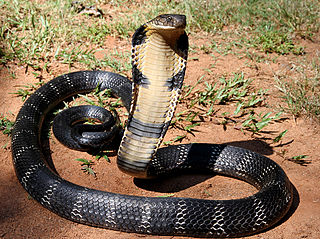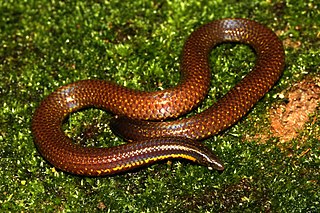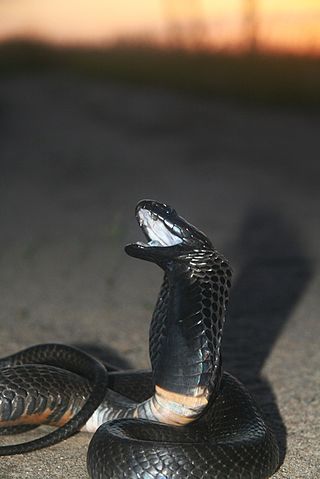
The king cobra is a venomous snake endemic to Asia. The sole member of the genus Ophiophagus, it is not taxonomically a true cobra, despite its common name and some resemblance. With an average length of 3.18 to 4 m and a record length of 5.85 m (19.2 ft), it is the world's longest venomous snake. The species has diversified colouration across habitats, from black with white stripes to unbroken brownish grey. The king cobra is widely distributed albeit not commonly seen, with a range spanning from the Indian Subcontinent through Southeastern Asia to Southern China. It preys chiefly on other snakes, including those of its own kind. This is the only ophidian that constructs an above-ground nest for its eggs, which are purposefully and meticulously gathered and protected by the female throughout the incubation period.

Cobra is the common name of various venomous snakes, most of which belong to the genus Naja.

Aspidelaps is a genus of venomous elapid snakes endemic to Africa. Species in the genus Aspidelaps are commonly called shield-nosed cobras, African coral snakes or coral cobras after their cobra hoods and enlarged rostral (nose) scales. However, the hood is not nearly as well developed in Aspidelaps as it is in the true cobras of the genus Naja.

George Albert Boulenger was a Belgian-British zoologist who described and gave scientific names to over 2,000 new animal species, chiefly fish, reptiles, and amphibians. Boulenger was also an active botanist during the last 30 years of his life, especially in the study of roses.

Uropeltis ellioti, commonly known as Elliot's earth snake and Elliot's shieldtail, is a species of snake in the family Uropeltidae. The species is endemic to India.

The Cape cobra, also called the yellow cobra, is a moderate-sized, highly venomous species of cobra inhabiting a wide variety of biomes across southern Africa, including arid savanna, fynbos, bushveld, desert, and semidesert regions.

Naja is a genus of venomous elapid snakes commonly known as cobras. Members of the genus Naja are the most widespread and the most widely recognized as "true" cobras. Various species occur in regions throughout Africa, Southwest Asia, South Asia, and Southeast Asia. Several other elapid species are also called "cobras", such as the king cobra and the rinkhals, but neither is a true cobra, in that they do not belong to the genus Naja, but instead each belong to monotypic genera Hemachatus and Ophiophagus.

The many-banded snake, also known commonly as the burrowing cobra, is a species of venomous snake in the family Elapidae. The species is native to Central Africa. There are three recognized subspecies.

Rhamnophis is a genus of arboreal venomous snakes, commonly known as dagger-tooth tree snakes or large-eyed tree snakes, in the family Colubridae. The genus is endemic to equatorial sub-Saharan Africa. There are two recognized species.

The rinkhals, also known as the ringhals or ring-necked spitting cobra, is a species of venomous snake in the family Elapidae. The species is found in parts of southern Africa. It is not a true cobra in that it does not belong to the genus Naja, but instead belongs to the monotypic genus Hemachatus. While rinkhals bear a great resemblance to true cobras they also possess some remarkable differences from these, resulting in their placement outside the genus Naja. In 2023, the Zimbabwe population was described as a new species, H. nyangensis.

The Egyptian cobra is one of the most venomous species of snakes in North Africa, and has caused many snakebite incidents to humans. It averages roughly 1.4 metres (4.6 ft), with the longest recorded specimen measuring 2.59 metres (8.5 ft).

Goldie's tree cobra, also known commonly as the African tree cobra and as Gold's tree cobra, is a species of venomous tree cobra in the family Elapidae. The species is native to Central and Western Africa. This species is one of the two tree cobras in Africa, the other being the black tree cobra. Goldie's tree cobra is one of the most venomous snakes and creatures in Africa.

The black-necked spitting cobra is a species of spitting cobra found mostly in sub-Saharan Africa. They are moderately sized snakes that can grow to a length of 2.2 to 3.0 m in length. Their coloration and markings can vary considerably. They prey primarily on small rodents. They possess medically significant venom, although the mortality rate for untreated bites on humans is relatively low. Like other spitting cobras, they can eject venom from their fangs when threatened. The neurotoxic venom irritates the skin, causing blisters and inflammation, and can cause permanent blindness if the venom makes contact with the eyes and is not washed off.

The forest cobra, also commonly called the black cobra and the black and white-lipped cobra, is a species of highly venomous snake in the family Elapidae. The species is native to Africa, mostly the central and western parts of the continent. It is the largest true cobra species with a record length of 3.2 metres.

Naja nigricincta is a species of spitting cobra in the genus Naja, belonging to the family Elapidae. The species is native to the deserts and drier regions of southern Africa. The species is largely nocturnal, and is often found while crossing roads at night. There are two recognized subspecies.
The black tree cobra is a species of venomous tree cobra found in central and western Africa. This species is one of the two tree cobras in Africa, the other being Goldie's tree cobra.

Lycodryas is a genus of snakes in the family Pseudoxyrhophiidae. The genus contains nine species, seven of which are endemic to the island of Madagascar, and two to the Comoros Islands. Its sister taxon is Phisalixella. All of the species are harmless to humans.

Dipsadoboa is a genus of snakes in the family Colubridae.

Hologerrhum is a genus of snakes in the family Cyclocoridae.

















